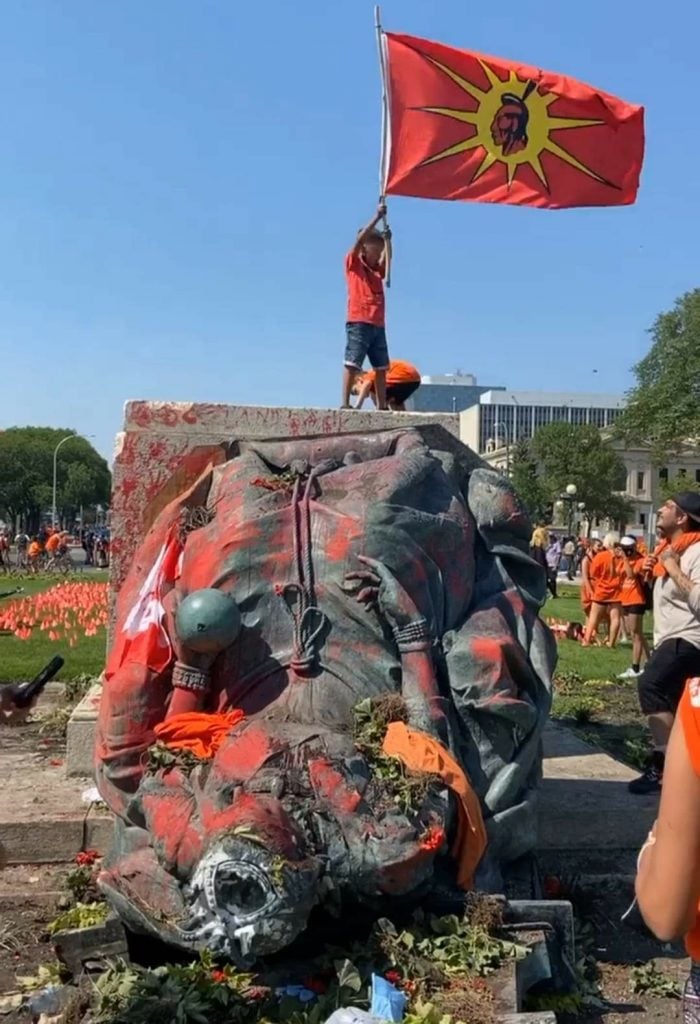Art World
Canadian Protesters Toppled Statues of Queens Victoria and Elizabeth II to Protest the Commonwealth’s Treatment of Indigenous Peoples
Discoveries of the remains of Indigenous children have been roiling the nation.

Discoveries of the remains of Indigenous children have been roiling the nation.

Caroline Goldstein

As Canadians celebrated yesterday’s anniversary of the nation’s confederation, protesters in orange shirts marched to the Manitoba legislature in Winnipeg and toppled statues of Queen Victoria and Queen Elizabeth. The statues are seen by some as symbols of colonizing forces, and chants of “bring her down” spread throughout the group,
The protesters’ orange shirts commemorated the Indigenous children who were sent to notoriously vicious residential schools where abuse and even death were common. At least 150,000 children were forcibly taken from their families over the course of a century as part of an attempt by the government to assimilate Indigenous children into Canadian society. Ongoing revelations of their unmarked graves have been roiling the nation.
Protesters covered the base of both statues with red handprints, and a red paint-splattered sheet covered Victoria’s head, as people tied ropes around her neck in order to bring down the monument. One man was arrested, though it is unclear what connection he had with the protesters. The activist group Idle No More led calls on social media for #CancelCanadaDay, and spread other hashtags including #NoPrideInGenocide, #BringOurChildrenHome, and #SearchEverySchool.
“Honour of the Crown”
The things they did (and still do) in your name.
Blood is also on your hands. #OhCanada pic.twitter.com/B2rILoUFwm
— Tanya Kappo (@Nehiyahskwew) July 1, 2021
In Victoria, which is Lək̓ʷəŋən Territory, a statue of Captain James Cook was dismantled and thrown into Victoria’s Inner Harbour and more red handprints were painted on the empty pedestal. Cheers erupted as the bronze figure fell onto the street, and red wooden dresses were placed around the statue to represent murdered and missing Indigenous women.
“The city of Victoria should remove all monuments that celebrate settler colonialism,” one Instagram user wrote in a caption to the video, “NO PRIDE IN GENOCIDE.”
Last month, protesters in Toronto felled a statue of Egerton Ryerson, a figure who is considered the architect of the residential school system.
The protests come on the heels of the Lower Kootenay Band’s announcement that the remains of another 182 children had been found in unmarked graves.
That comes after news in May that the remains of more than 200 children were found on the grounds of a former residential school in unmarked graves. The discovery at Kamloops Indian residential school, which was the largest school of its kind in Canada, prompted outrage among citizens, especially those within the Indigenous community. At the time, Prime Minister Justin Troudeau called it a “tragedy” that “kids were taken from their families, returned damaged, or not returned at all.”
In June, Vancouver-based artist Tamara Bell installed 215 pairs of shoes on the steps of the Vancouver Art Gallery to represent the children discovered in May, and community members placed flowers, messages, and stuffed animals alongside the grim display.
In a statement on Canada Day, Trudeau said that “the horrific findings of the remains of hundreds of children at the sites of former residential schools in British Columbia and Saskatchewan have rightly pressed us to reflect on our country’s historic failures, and the injustices that still exist for Indigenous peoples and many others in Canada.” He added: “We as Canadians must be honest with ourselves about our past.”